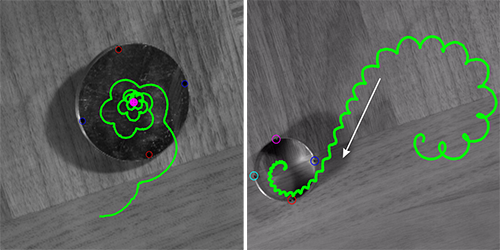September 25, 2015 report
Spinning ring on a table found to behave more like a boomerang than a coin

(Phys.org)—A trio of researchers, two with the University of California, the third with Sharif University of Technology, in Iran, has found that a common ring, such as is worn on the finger, spins differently on a tabletop than does a coin. In their paper published in Physical Review E, Mir Abbas Jalali, Milad Sarebangholi and Reza Alam describe their tests and observations and offer a theory on why a spinning ring behaves the way it does.
If you use your fingers to spin a coin on a tabletop, it will tend to move around on the table in the same direction that it is spinning until it stops. That is not the case with a spinning ring, the researchers found (first by simply noticing it and then via testing). Unlike the movement of the coin, the ring will move first in the direction of its spin, but then will stop moving and reverse itself, moving against its own spin.
A coin, the researchers note, tends to spin in the same direction as its spin due to friction—and that appears to be the case with a ring as well. Both also, at least initially spin atop a thin layer of air that gets trapped beneath one of its edge and the tabletop. But, because the ring, which is essentially the same thing as a coin except for the large hole in it, has that hole, the trapped air can escape. When it does, the researchers theorize, the frictional forces change, resulting in the ring stopping and changing directions.
Intrigued by the odd movement of the spinning ring, and surprised that they could not find any description or study of it in the literature, the researchers set about studying the phenomenon in their lab. They created coins by cutting metal rods and rings by cutting metal tubes, both of a variety of different sizes and thicknesses and then set them to spinning while recording with a high-speed camera.
In studying the video, it became apparent to the researchers that the change in direction came about due to the change in air flow. They also discovered that the reverse-effect occurred with all of the rings they tested, suggesting the behavior is both consistent and replicable, traits they suggest, that might be useful when designing objects that move on topologically flat surfaces, especially those that require complicated reorientations or automatic reversals.
More information: Terminal retrograde turn of rolling rings, Phys. Rev. E 92, 032913 – Published 22 September 2015 , dx.doi.org/10.1103/PhysRevE.92.032913 . On Arxiv: arxiv.org/abs/1412.1852
ABSTRACT
We report an unexpected reverse spiral turn in the final stage of the motion of rolling rings. It is well known that spinning disks rotate in the same direction of their initial spin until they stop. While a spinning ring starts its motion with a kinematics similar to disks, i.e., moving along a cycloidal path prograde with the direction of its rigid body rotation, the mean trajectory of its center of mass later develops an inflection point so that the ring makes a spiral turn and revolves in a retrograde direction around a new center. Using high speed imaging and numerical simulations of models featuring a rolling rigid body, we show that the hollow geometry of a ring tunes the rotational air drag resistance so that the frictional force at the contact point with the ground changes its direction at the inflection point and puts the ring on a retrograde spiral trajectory. Our findings have potential applications in designing topologically new surface-effect flying objects capable of performing complex reorientation and translational maneuvers.
Journal information: Physical Review Letters , arXiv
© 2015 Phys.org




















